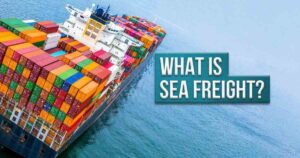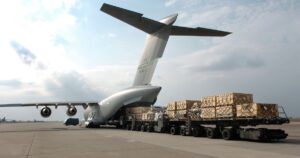Airfreight vs Sea Freight- When shipping commodities internationally, deciding between sea freight and airfreight lines can be a difficult enterprise. Depending on your hosting needs, you might prefer air or sea freight. Cargo is transported by aircraft so air freight is much faster than sea freight.
Air freight is pricier per kg/lb than sea freight. Cargo is shipped on container ships and bulk cargo carriers with sea freight and it is more cost-effective for high-volume shipments. But, of course, transit times are much longer with cargo having to move by boat.
Factors such as the nature of goods, cost, perishability, and importance of the goods, also play a role in deciding which mode of transport to use. This can help you understand the tradeoffs in the shipping process when it comes to speed, cost and weird cargo requirements.
What is sea freight?

Sea freight is shipping goods on ships across oceans. It moves a lot of products between countries. We call it ocean freight too. They put things in big metal boxes called containers. The containers go on big ships. The ships haul the containers over the water to different harbors.
Sea freight is cheaper than other ways to transport heavy or large things. The ships can carry a whole lot of containers at once. It takes longer than planes to get things there. But it is cheaper than flying. Sea freight is good for items that do not expire like canned food. It works well for shipping non-perishables over faraway places.
What is air freight?

Air freight helps move things by plane. Goods are loaded onto aircraft to fly to different airports. It is faster than moving things by boat or truck. Planes can fly directly to places without traffic delays. Air freight is quick. Planes take only days or weeks to deliver things depending on where they go. It is also reliable worldwide. This makes it good for things that can spoil, expensive items, and urgent deliveries.
Although air freight costs more than boat freight, it is faster. Boats take longer to deliver things over water. The speed of planes means companies can get products to customers much quicker by air compared to other ways. While more expensive, air freight offers fast delivery times which can be important.
6 Components to consider when choosing between ocean cargo and discussing cargo.
There are a few critical components to assess when choosing between ocean cargo or discussing cargo for shipping cargo globally. The toll per kilo is more often than not much lower for ocean cargo, but travel times are essentially speedier for discussing cargo.
1. Budget
Sea freight is generally cheaper than air freight for large cargo loads. One study found air freight costs 12-16 times more than sea. A $100 sea shipment could cost $1200 by air. However, for smaller packages with less than a container load, sea freight pricing is based on cubic meters, sometimes exceeding air rates. Freight platforms like Freightify allow comparing rates from over 30 ocean carriers and 90 airlines, providing real-time data to quickly assess the best low-cost solution for any shipment size.
2. Timeline
Air freight delivers goods much faster than sea freight, typically in days versus weeks. While some fast “express” sea options exist, air remains quicker. Air freight ensures goods reach remote locations irrespective of “last mile” support needs. Sea freight faces port delays, customs holds and weather impacts. Missing air freight deadlines isn’t as costly as sea delays due to daily flight frequency. Freightify’s carrier and airline schedules empower faster shipment planning and control over deliveries by air or sea.
3. Amount of cargo
The image shows MSC Irina, the world’s largest cargo ship capable of holding 24,346 twenty-foot containers. Each holds 1,172 cubic feet, so the total volume is astronomical. In contrast, a freighter Boeing 747 holds only 26,000 cubic feet – a tiny fraction of a ship’s capacity. Sea freight is better for bulky, heavy or large-scale shipments given vast container volumes. However, if perishable goods or tight schedules require it, air freight’s speed is preferable despite far less space.
4. Environmental impact
The environmental impact of sea freight versus air freight depends on factors like fuel usage, emissions and sustainability. Generally, sea freight has a lower carbon footprint than air freight per ton of cargo moved. This is because planes emit more greenhouse gases during transit. In fact, flights emit 500g of CO2 per metric ton-km on average versus just 10-40g for ships. New regulations will further reduce ship emissions by 2024 through limits and carbon credits, solidifying sea freight as the greener choice for environment-focused businesses wanting lower carbon footprints.
5. Cargo safety
Cargo safety has competing perspectives. Some argue air freight has less risk of damage or theft since goods face fewer handlings and transfers under close monitoring in secured airports. However, others claim sea freight in standardized containers tightly packed on ships also offers a secure environment with risks from weather and procedures considerably low. Large volume goods may have lower risk through sea freight where air could be preferable for higher value small loads, as the choice depends on cargo type and how well operations are managed through loading and unloading at origin and destination.
6. Restriction on the type of cargo
Both ocean and cargo confront confinements, but ocean cargo overseas to offer more adaptability in general. Discuss cargo charges numerous extreme confinements like tight security, weight stipends, and proscriptions on perilous products like chemicals, magnets and flammables.
Ocean cargo can alter a more extensive diverse of cargo sorts inside its imperatives of traditions rules, import/export directions and harbour arrangements. Whereas both have challenges, discussing freight’s harder measures on cargo choice regularly positions the ocean as the more widespread choice for most shipping needs.
Deciding Whether Air Freight or Sea Freight is Right for You

When shipping developments internationally, one of the first main judgments is whether to use air or sea freight. There are several elements to think in creating this selection. The type of goods being shipped and their value, size, weight and any perishability requirements will impact logistical needs.
The urgency of delivery timelines and how long your customer is willing to wait also matters. The distance of travel and destination country infrastructure play a role. And of course, cost is a primary consideration – air freight is far more expensive per kilo but much faster.
Proper evaluation of these deciding elements will clarify whether time-sensitivity takes priority over budget, or vice versa. Carefully analyzing your unique shipping needs against the core capabilities of air and ocean solutions helps determine the right fit for your business goals and product attributes.
How is Air Freight vs. Sea Freight Calculated?
When getting quotes for international air freight or sea freight shipments, carriers will generally provide pricing based on weight and dimensions. Air freight is typically quoted based on chargeable weight, either the actual weight or dimensional weight (length x width x height in inches/centimeters), whichever is greater.
Sea freight is often quoted per container or based on weight, volume or twenty-foot equivalent units (TEUs). Additional charges may apply depending on specific shipment factors like high-value cargo insurance, customs clearance fees, duties and taxes. Delivery timelines also impact air and ocean rates, with expedited services costing more.
Understanding how carriers derive pricing helps shippers weigh options and properly classify items to avoid unexpected overages. Comparing accurate air vs sea rate structures is essential for budgeting transportation costs.
Pros and Cons of Air Freight vs. Sea Freight
Here’s a table resembling the pros and cons of air freight versus sea freight:
| Aspect | Air Freight | Sea Freight |
| Speed | – Pros: Fast delivery (1-3 days) | – Pros: Suitable for non-urgent shipments (1-6 weeks) |
| – Cons: High speed comes with a higher cost | – Cons: Slower transit times | |
| Cost | – Pros: Lower inventory carrying costs due to quick delivery | – Pros: Cost-effective for large and heavy shipments |
| – Cons: Higher transportation costs | – Cons: Higher inventory carrying costs due to longer transit | |
| Reliability | – Pros: High reliability and on-time delivery | – Pros: Reliable for non-urgent shipments |
| – Cons: Subject to weather delays and air traffic congestion | – Cons: Possible delays due to port congestion and customs | |
| Capacity and Size | – Pros: Suitable for small, high-value, or time-sensitive items | – Pros: Can handle large, bulky, and heavy shipments |
| – Cons: Limited capacity and size for shipments | – Cons: Less suitable for small, urgent shipments | |
| Environmental Impact | – Pros: Less packaging required due to faster transit | – Pros: More fuel-efficient and lower CO2 emissions per ton |
| – Cons: Higher carbon footprint per ton | – Cons: Requires more packaging due to longer transit times | |
| Regulations | – Pros: Fewer regulations for certain types of goods | – Pros: Suitable for a wide range of goods |
| – Cons: Stricter security measures | – Cons: More complex regulations and customs procedures | |
| Flexibility | – Pros: Frequent flights and flexible schedules | – Pros: Ideal for large volumes and long-distance transport |
| – Cons: Less flexible in terms of size and weight | – Cons: Fixed schedules and routes |
This table highlights the main considerations when choosing between air and sea freight for shipping goods.
FAQ’s
Which is way better, discuss cargo or ocean cargo?
Discuss cargo is speedier but more exorbitant, ocean cargo is moderate but more reasonable.
Which is superior for you to send merchandise by discuss or by ocean?
Discuss cargo is faster but ocean cargo is more taken a toll compelling for non-urgent cargo.
What are the comparative focal points of universal discussion and sea transportation?
Discuss cargo is speedier whereas ocean cargo has more down costs but is slower.
Is ocean cargo more ecologically neighborly than discussing cargo?
Ocean cargo is regularly more ecologically neighborly than discuss shipment due to lower carbon outflows.
Conclusion
whether air or sea freight is best for your needs will depend on several factors specific to your particular shipment. Air freight is ideal if you need to transport small goods, time is of utmost importance, or you require rapid delivery.
However, sea freight will likely be more cost-effective for larger and less time-sensitive loads. You’ll need to weigh factors like shipment size, value, urgency, and your budget to determine the optimal option. Both air and ocean cargo transportation have their advantages, so consider all dimensions before deciding.
Analyze your shipment specifications, delivery timetables, and cost constraints to select the mode fitting closest to the unique requirements of getting your goods from point A to point B. A thorough needs analysis will reveal whether air or ocean transport is right for your freight.

